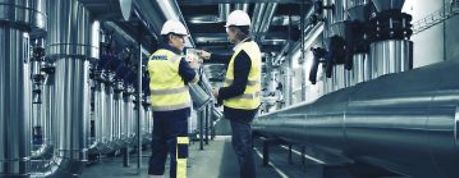The brain behind your operation: Metris addIQ control systems
ANDRITZ reactor internals
Engineered for reliability
ANDRITZ Euroslot and ANDRITZ Fiedler, both members of the ANDRITZ GROUP, together provide a unique breadth and depth of expertise across a range of industry sectors – from oil and gas, to petrochemicals and refineries, water treatment, filtration, food processing, and the paper industry.
Clients value the company’s extensive service in the fields of design, manufacture, and site installation of reactor and column internals.
Hydroprocessing reactors in the refining and petrochemical industries require very specific designs to achieve good performance over the years and minimize maintenance turnaround.
ANDRITZ delivers production units for reactor internals to achieve optimum and trouble free operations, considering the following parameters as key elements:
- Uniform distribution
- Severe pressure and design pressure compliance
- Thermal stability of components
- Maximizing of catalyst volume and duration of operating cycles
- Low fouling system reducing potential pressure drop build-up
Feed diffuser and vortex breaker
The feed diffuser guides the incoming flow from the inlet nozzle towards the reactor

Feed Diffuser
Liquid distributor trays
The liquid distributor tray distributes the incoming flow over the entire vessel cross section.
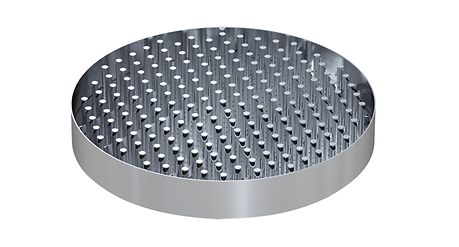
Liquid distributor tray
Support grids
The support grid is a retention device for the catalyst and extends over the entire cross section of the vessel.

Support grid
Quench injections, collection trays, and mixing chambers
The mixing system comprises a horizontal collection tray, a mixing chamber positioned below the collection tray, and at least one passageway extending through the collection tray into the mixing chamber. This mixing chamber and the collection tray define a two-phase mixing volume. The passageway conducts fluid from above the collection tray into the mixing chamber, which preferably includes at least one outlet opening for the downward passage of fluid.
In particular, mixing of quench fluid is significantly improved when quench is introduced into a region above the collection tray and where a preferred direction of quench injection is selected to cause a rotational flow on the collection tray.

Quench pipe and mixing tray
Outlet collector
The outlet collector collects the flow from the reactor to the outlet vessel nozzle. In a standard downflow pattern, the outlet collector is either hidden in an inert ball bed that fills the bottom part of the reactor or underneath a support grid, where it distributes or collects the flow. In the latter, it can also be designed as a safety retention device in case of catalyst leakage. Under reverse regeneration conditions or in normal upflow operation, the outlet collector is located below the top vessel nozzle, where it operates in the opposite direction to a feed diffuser. In case of fluidization of the bed or possible entrainment of catalyst, it is designed to retain the catalyst. The same design features are implemented in order to ensure good sealing.
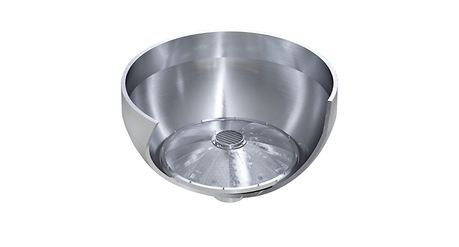
Outlet collector
Center pipe, inner screen
The center pipe/inner screen is the central screening components in radial flow systems. Its general shape is a cylinder, where the outer surface delimits the inner side of the catalyst bed. It is usually installed inside vertical reactors and collects or distributes the flow.

Center pipe
Scallops
The scallops assembly forms the outer screen component of a radial flow system. Its general shape extends parallel to the inner vessel wall using the wall as support. The inner surface delimits the outer side of the catalyst bed. Its purpose is to distribute and collect the flow.

Scallops
Outer baskets
The outer baskets are the outer screen components of a radial flow system. Their general shape extends parallel to the inner vessel wall. The surface of the baskets delimits the outer side of the catalyst bed and its purpose is to distribute or collect the flow.

Outer basket
SSR flow
The SSR-Flow assembly forms the outer screen component of a radial flow system. It enhances the outer basket technology by combining its cylindrical shape and flexibility of installation through the reactor manhole. The SSR-Flow assembly is the ideal solution for replacing existing outer baskets instead of using standard scallops or bolted panels.
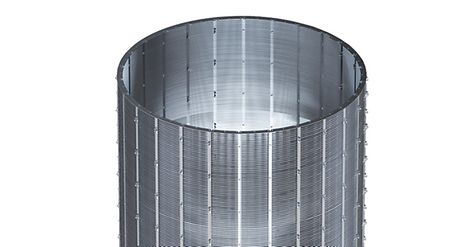
SSR flow elements combined to form an outer basket
Header and laterals
A collector/distributor uses a header pipe or a hub to which several screen tubes are attached in order to enable excellent collection or distribution of a gas or a liquid within a medium without wall effects or channelling in order to maximize efficiency.
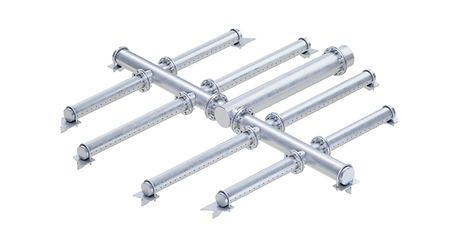
Header & Lateral


